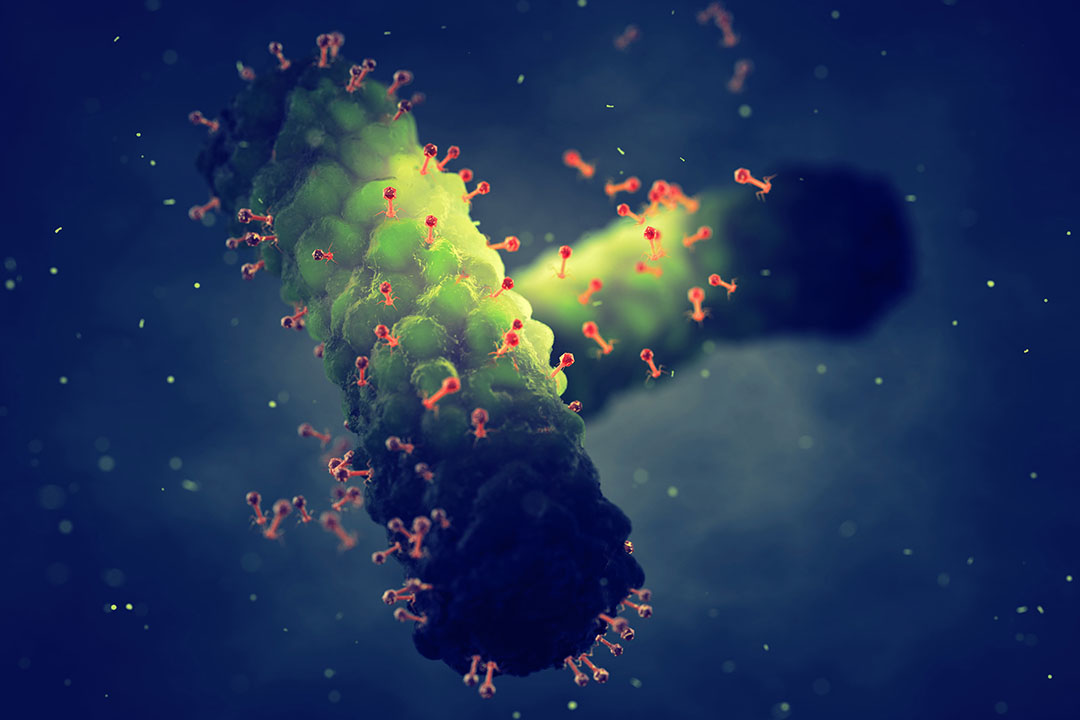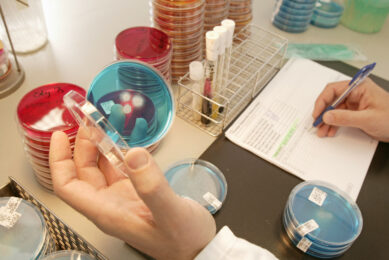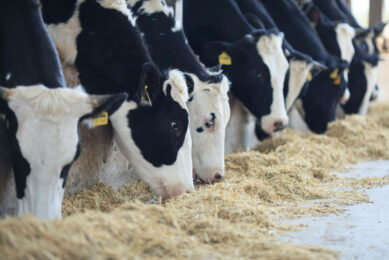Bacteriophages role in poultry production

Bacterial infections of the intestines pose a challenge in poultry farming due to the ban on antibiotic use for growth promotion. Bacteriophages offer great potential as an alternative to the use of antibiotics in animal feed. They can also be explored in the fight against bacteria that are resistant to antibiotics and to reduce the risk of developing and spreading antibiotic-resistant bacteria.
Bacteriophages are viruses that can infect and kill bacteria. Current research efforts are looking at using phages to kill strains of bacteria that are known to cause disease in poultry. Bacteriophages would be a very good replacement of antibiotics, since their recognition and destruction mechanisms are vastly different from antibiotics and thereby will circumvent any resistances the bacteria have obtained, see Figure 1. In addition, when applied in livestock, any bacterial resistance that might arise will not interfere with antibiotic treatment in humans. Moreover, bacteriophages are relatively easy to produce and therefore quite cheap.
Figure 1 – Lytic cycle of bacteriophages.
Intestinal health
Here the role of bacteriophages will be explored in relation to some intestinal health challenges in poultry.
Campylobacter
Intervention strategies focused at the start of the food chain (i.e., the broiler farm) are most likely to yield the greatest reductions of Campylobacter contamination in retailed poultry meat. In the study of Carrillo et al. (2005), bacteriophages were isolated from a range of sources, including broiler chicken excreta, free-range layer-chicken excreta, and processed chicken meat. Bacteriophages CP8 and CP34 were orally administered to 25-day-old broiler chickens experimentally colonised with the C. jejuni broiler isolates; the phages lysed 84 and 63 of the 130 campylobacters tested, respectively. Phage treatment of C. jejuni-colonised birds resulted in Campylobacter counts reducing to between 0.5 and 5 log10 CFU/g of ceacal contents compared to untreated controls over a 5-day period post-administration. In another study, phage inoculated onto the surface of skin contaminated with Campylobacter exhibited a control effect; this suggests the possible use of bacteriophages in connection with other measures to control chickens contaminated with Campylobacter.
E. coli
A comparison of bacteriophage treatment to antibiotics in broiler chickens was demonstrated by Xie et al., 2005. The results of this study showed that the phage Esc-A was as effective (even better) as antibiotic Chloromycetin. In their following study, they also found that chickens treated with phage showed resistance to other intestinal diseases, such as infectious bursal disease; they suggested that due to their high specificity, phages do not affect other profitable microbes, thus keeping a favourable intestinal micro-ecological balance. The efficacy of bacteriophages against E. coli is also demonstrated in the study of Huff et al., 2002. In this study, the mortality of broiler chickens decreased from 85% in birds challenged with 104 CFU of E. coli to 35% when mixed with 104 PFU of the bacteriophage, and no mortality occurs when mixed with 108 PFU of bacteriophage.

Salmonella
Diseases such as salmonellosis affect poultry farming; it poses a risk to the health of the farmers and consumers. The efficacy of bacteriophages as bio-sanitiser agents are observed in the study of Hungaro et al., 2013 (Figure 2). In this study, chicken skin experimentally contaminated with S. enteritidis were treated with phage cocktail or chemical agents, similar reductions of about 1 log CFU/cm2 were observed.
Figure 2 – Reduction of S. enteritidis counts in chicken skin treated with bacteriophages and chemical agents.

Differences in the effectiveness of bacteriophages were observed by Atterbury et al. (2007). They found that the first phage reduced S. enterica serotype Enteritidis ceacal colonisation by ≥4.2 log10 CFU within 24 h compared to the control, the second phage reduced S. enterica serotype Typhimurium by ≥2.19 log10 CFU within 24 h, but the third bacteriophage was ineffective at reducing S. enterica serotype Hadar colonisation. The authors concluded that selection of appropriate bacteriophages and optimisation of both the timing and method of phage delivery are key factors in the successful phage-mediated control of salmonellas in broiler chickens. The reduction of E. coli and Salmonella (Table 1) due to supplementation of bacteriophage at 0.5 g/kg results in an increase of lactobacillus concentration; which suggests the phage provided a better ecosystem for the development of the lactobacillus.
The supplementation of bacteriophage during the first 2 weeks in broilers shows a higher body weight gain and improved feed conversion; the younger chicks are more susceptible to pathogens and sensitive to the additives that can inhibit those potential pathogens. Similarly, Atterbury et al. (2007) demonstrated that a higher dosage of bacteriophage is desirable to maintain growth performance by reducing the S. enteritidis and S. Typhimurium in caecal content, see Table 2.
The future of bacteriophages
Various factors determine the efficacy of phage therapy in animals; the persistence of the phage in the host, the number and concentration of the dosage, the developmental phase of the animal, and the virulence – which is an important characteristic that determines the phage’s ability to induce the lytic cycle in the host bacterium. Bacteriophages are very specific. Since they are very specific, more than one phage might be needed to eliminate different strains of the same pathogen. In line with that, some bacteria might escape phage infection by lack of expression and mutations (alterations) of the phage docking sites. A possible solution is the application of well-selected phage cocktails containing multiple phages.
Bacteriophages have great potential for reducing the use of antibiotics in poultry. Even in the case that they might not fully replace antibiotics, they can be a good addition and might be used in combination with them – where legislation allows the use of antibiotics. The current situation suggests the lack of in-depth research as the main hampering factor in the therapeutic use of bacteriophages.
References on request







